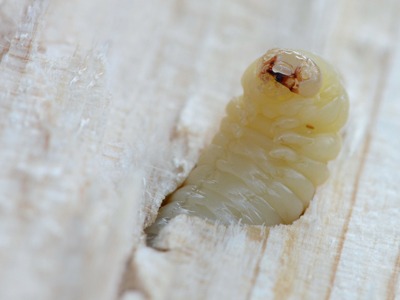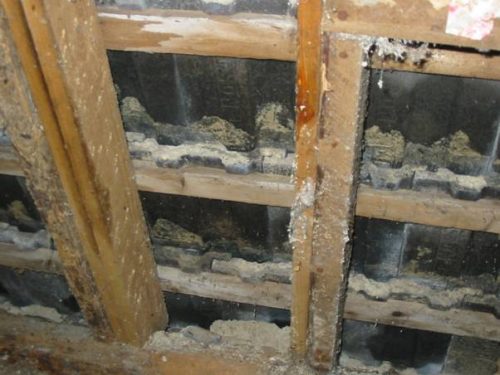Woodworm Beetles can affect untreated timbers anywhere in your Home.
Recent surveys have found woodworm beetle infestations in over 70% of the locations surveyed. Often caused by Anobium Punctatum or the Common Furniture Beetle, infestations cost hundreds of thousands Euro worth of damage each year. The long life cycle of wood boring beetles means that the infestation may not immediately manifest into visible holes. Therefore an effective woodworm prevention strategy is every bit as important as an effective treatment programme.
How can you tell if you have Woodworm?
To begin with, woodworm gets its start when a female beetle lays her eggs into cracks in the wood, or inside old exit holes. The eggs hatch after approximately three weeks, each producing a larva around 1 millimetre in length. For three to four years the larvae eat through the affected timber, growing up to 7 millimetres long in that period. They come nearer to the wood surface when ready to pupate, excavating small holes just under the wood surface. As adults, these wood boring beetles break through the surface, making a 1mm to 1.5 millimetre exit hole which results in the spilling of dust; the first visible signs of an infestation. Pupated woodworm beetles do not feed; they only reproduce and thereby complete the life cycle. However, they are capable of flying a considerable distance which means necessary treatment is often not limited to one area.


Why do you get Woodworm?
The level of moisture content in your timbers is why you get woodworm. A relative humidity above 60% increases the likelihood of woodworm becoming an issue. By contrast, timber moisture content below 12% is considered too dry for an infestation to occur. Wood boring beetles typically only attack seasoned sapwood timber, not live or fresh wood. Also, they usually does not attack heartwood timbers. This is readily observed from surveying infested structures. Whereby one piece of timber has been heavily attacked and an adjacent one is left virtually untouched. Woodworm infestations are generally a problem of old wooden houses that were built with untreated timbers.
We have over thirty years experience in providing Quality Treatments that eliminate Woodworm Beetles.
Treatment
We offer clients a wide range of services including a comprehensive survey to identify the areas of infestation. Along with a complete treatment of the affected areas and full reinstatement of previous surface finishes.
How do you get rid of Woodworm?
To treat it effectively, the larval stage of the life cycle of the wood boring beetle needs to be targeted. A water-based woodworm treatment is most effective as the chemical soaks into the timbers, killing existing infestations but also protecting against any future outbreaks. This type of treatment is safe for people and pets who may be in the vicinity of the treatment area.
However, in cases of extreme infestations, or where structural timbers have been significantly affected, the timber may have to be replaced with a treated replacement piece. In most cases this is not required due to the effectiveness of the Chemical Woodworm Treatment.

If you suspect that you have an issue with Woodworm, or for more information on our Timber Repair services, please Contact Us today!
Phone: +353 42 974 1495
Mobile: +353 87 243 2564
Email: info@mcguinness.ie